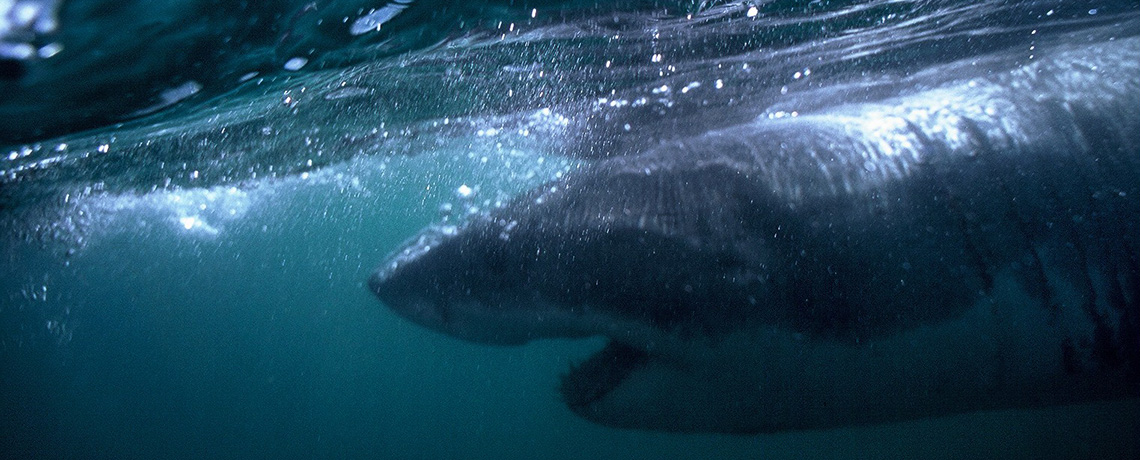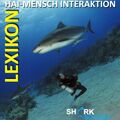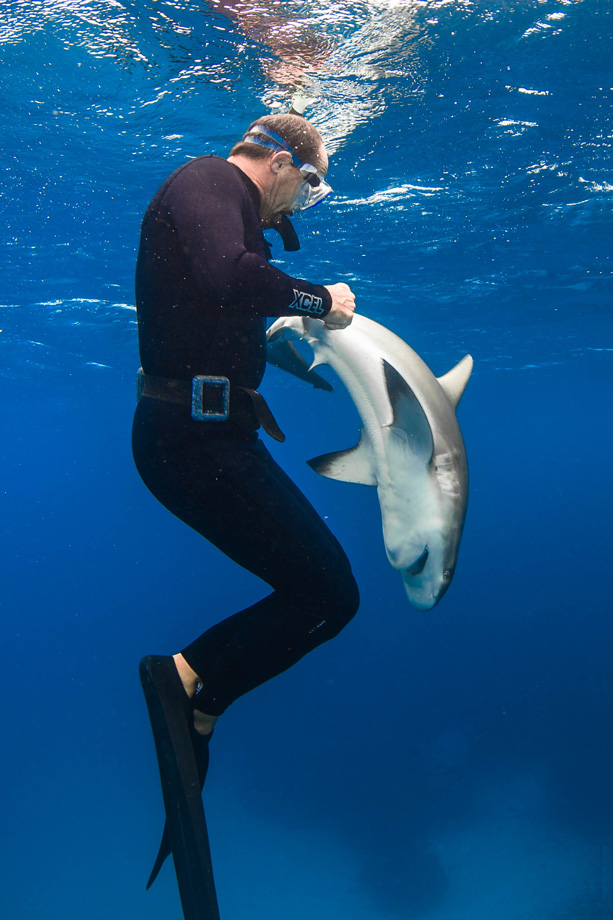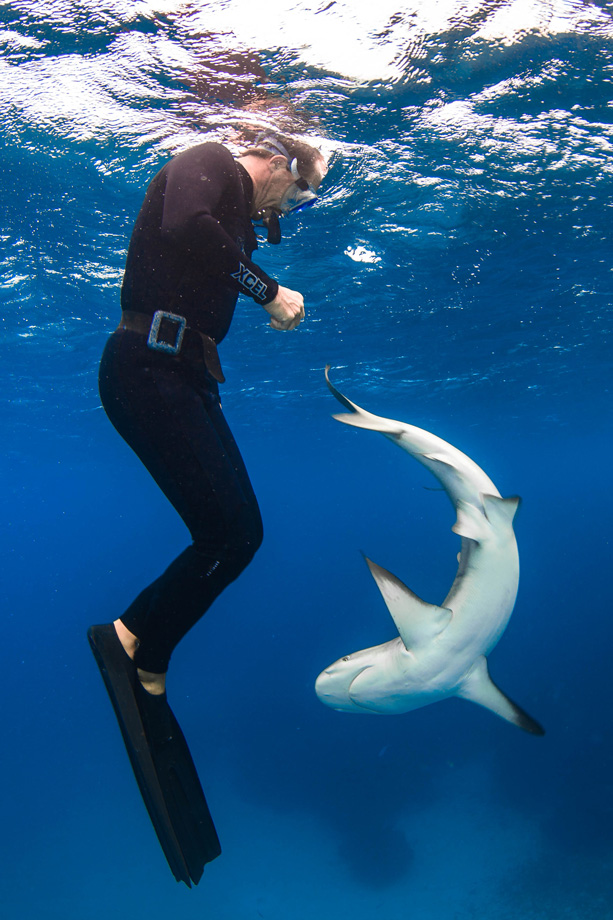Recommendations
Since the following recommendations and suggestions are based on on-going research at SERC (the SharkSchool™ - Center in the Bahamas), in cooperation with SAVN and GSAF, we encourage everybody to come back once in a while to check on updates. If you can’t find the answer you are looking for, contact our office.
!!! Rescue rules, as well as "Ritter's Facing Rules" (aka Ritter-Rules), are listed at the bottom of this page !!!
Should a person feel uneasy in the presence of a shark and can’t withdraw, a certain procedure should be followed.
STOP-FACE-GUIDE-PUSH-MOVE-GILL
STOP: Does a shark seem to be interested in a person, one should immediately cease every activity (noise reduction), and either stand up (at a beach) or go vertical, and letting the legs hang loose if the water is too deep to stand.
FACE: Always turn towards the shark and pivot (turn) with the shark.
GUIDE: Should a shark swim directly towards a person and is in touchable distance (without having to lean forward with the upper body), one should guide the shark by touching its snout or top of the head area.
PUSH: Is it necessary to have a more forceful response, it is OK to push a shark as long as one does not hit the animal. Pushing is always recommended should a shark approach in a frontal manner.
MOVE: If a shark comes back a few more times, and one starts to feel threatened, one should move towards the shark. Sharks are not used to being approached. Such a move suggests another predator and the appropriate reaction (backing off) by the shark will follow.
GILL: Whenever sharks try to hurt or kill each other, they “go for” the gills. Although humans are unknown to sharks, the response will be the same as if another shark would have tried it. Even the pure water pressure of a hand (when close to the gills) is enough to get the appropriate reaction (backing off).
General Recommendations
RECOMMENDATION: Never touch, corner or harass a shark.
REASON: Sharks can get stressed or feel threatened and defend themselves.
RECOMMENDATION: Don’t swim between breakers.
REASON: Sharks prefer such area because of the oxygen-enriched water, but the reduced visibility, shallowness and human presence (unknown object) can stress the animals.
RECOMMENDATION: Avoid swimming or bathing close to sandbars.
REASON: All natural structures attract marine life. Mainly fish patrol along them, and quite frequently attract sharks as well for the same reason. Sharks won’t startle easily if the visibility is good but the shallowness and sandy bottom often reduce visibility around the breakers. Sharks may hunt around sandbars and may see a competition in a person’s presence. Or a shark is attracted by the sound of scared off fish due to a person’s appearance.
RECOMMENDATION: Don’t swim into the glare.
REASON: It is rather difficult to see a shark below the surface should one have to look towards the sun (the same is true for lifeguards). Furthermore, inquisitive sharks often approach with the sun in their back to have an advantage.
RECOMMENDATION: Avoid swimming at night.
REASON: There is evidence that sharks (some species at least) get closer to shore during evening or nighttime hours. Despite their increased ability to see during crepuscular times (dusk, dawn), at complete darkness (no moon) they rely more on their hearing. But since they can’t know how loud a sound might be at its origin (human being) it may happen that they accidentally come very close or even swim into a person.
RECOMMENDATION: Avoid murky water.
REASON: Some species prefer murky water to hunt where they primarily rely on their hearing, and might notice a person very late, possibly leading to stressful situations.
RECOMMENDATION: Never swim close to / at / in river mouths.
REASON: Freshwater plankton dies in sea or brackish water, offering a prime food source for shore oriented fish species, or species particularly adapted to brackish water. Rivers also often carry larger animal carcasses. All this type of food, and the animals feeding on it attracts sharks. The low visibility, mixed with all the different sounds (feeding fish etc.) may enhance the excitements of sharks. Such sharks have the tendency to feel easier threatened and defend themselves than the ones who are not attracted by such triggers.
RECOMMENDATION: Carefully cross channels between sandbars.
REASON: These areas are a preferred hangout for sharks. Increased currents are likewise a factor to be considered which requires a person to swim harder, possible creating attractive sound patterns for the sharks.
RECOMMENDATION: Docks and jetties should be avoided.
REASON: Sharks prefer these areas because ships always throw food overboard which attracts a variety of fish. Likewise the sounds created around these areas can be intriguing as well. Furthermore sharks like to patrol along structures but can get stressed should a person come to close reducing the animals’ escape routes.
RECOMMENDATION: Avoid swimming or bathing down-current of active fishing piers.
REASON: Hooked fish always release stress hormones and bodily fluids, which will be carried with the current and sharks, may then swim up-current towards the source. Do people swim in these odor corridors they not just smell like something sharks know but may also sound (splashing) like something they know, and may check it out.
RECOMMENDATION: Don’t swim close to cliffs.
REASON: Stronger currents may occur around cliffs, connected to mostly lower visibility, and accumulation of organism (due to the increased current). Sharks can also get cornered in such areas due to surf and current, leading to potentially dangerous situations.
RECOMMENDATION: Avoid pilings.
REASON: Structures attract a variety of organism for many reasons. It also traps a lot of food due to eddies (behind the pilings) which then lure in larger fish and sharks.
RECOMMENDATION: Avoid areas where dolphins jump around the same area.
REASON: If dolphins porpoise at one spot it indicates hunting. Sharks and dolphins often chase the same fish.
RECOMMENDATION: Avoid swimming close to diving birds.
REASON: Diving birds indicate fish below the surface. Sharks are likely to be present as well.
RECOMMENDATION: Be always aware what animals are close by.
REASON: The change of their behavior can indicate the appearance of sharks. They may swim more anxious, look for cover or vanish. If noticed, cease, reduce / stop movement (noise) and look around.
RECOMMENDATION: Don’t chase off fish that swim close by.
REASON: Exaggerated swim motions of fish create attractive sounds for sharks. An approaching shark may see a person as a competitor. A shark may also try to compare the person with the created search image (based on sound) and starts examine the person further.
RECOMMENDATION: When fish start to mingle around a person, leave the water.
REASON: Such fish look for cover because of the appearance of predators in closer vicinity. Since a person is mostly moving around, the fish have to follow (creating different sound patterns).
RECOMMENDATION: Does water start to “boil” (fish jump and dart around at the surface), leave the water.
REASON: Predatory fish and shark chase down food fish.
RECOMMENDATION: Don’t attach fish to your body while spearfishing.
REASON: Sharks are attracted by such activities, trying to get to the fish.
RECOMMENDATION: Be aware of your surroundings when getting a fish off the spear.
REASON: Never take your attention off your surroundings (always look behind) when spearfishing. Struggling / dying fish create the most attractive sounds for sharks.
RECOMMENDATION: Often change the site up current when spearfishing.
REASON: Bodily fluids and stress hormones of killed or injured fish will be carried away with current, creating search images in sharks. Despite that such an image will not be confirmed when seeing a person, human created sound pattern, together with the picked up smell, enhances curiosity.
RECOMMENDATION: Never defend your catch (spearfishing) against sharks.
REASON: Sharks will interpret such as legitimate competition and will try to fight for the fish.
RECOMMENDATION: Never surf close to seal haul-outs.
REASON: Despite that sharks do not mistake a surfer for a seal; its curiosity may be increased to further investigate this unfamiliar object.
RECOMMENDATION: Avoid surfing in murky water.
REASON: Low visibility reduces the chance for a shark to notice the presence of a surfer early on. As such a shark may just follow a paddling surfer assuming a familiar object (based on the sound pattern) prior to visual contact.
RECOMMENDATION: Stop moving on a surfboard when seeing a shark.
REASON: Any motion creates sounds that may enhance a shark’s curiosity. It is best to get off a board, holding onto it and get into a vertical position. Such position reduces sounds. Sitting on a board often increases sound patterns (waves are hitting the board and a person compensates with his arms and legs).
RECOMMENDATION: Leave the surf spot, should a shark not move on.
REASON: Falling off a board, paddling out, sitting on the board always creates attractive sound patterns for sharks.
!!! Rescue Rules !!!

RECOMMENDATION: Is the shark still in the vicinity of the victim when the rescuer arrives at the site, he / she must always first deal with the shark before turning his / her attention towards the victim.
REASON: As long as the shark’s intention - or the general situation - is unclear, it could create an additional danger for a rescuer and / or the victim.
RECOMMENDATION: Always position yourself between the shark and the victim.
REASON: Such a position makes it easier to keep a shark away from the victim (FACE-GUIDE/PUSH-MOVE) should it approach again.
RECOMMENDATION: Don’t pull the victim away from the shark, push the shark off.
REASON: Pulling something away from a shark - even if unknown to the animal - in close vicinity may create a “chase & claim response” despite that sharks do not hunt down humans. Changing a situation between a human being and a shark may lead to a change in the animal’s motivation.
RECOMMENDATION: Don’t move the victim if the shark is not at least facing away.
REASON: To move something away from a shark that got its attention a short while ago, may still be the reason for its presence and may trigger a “chase & claim response.” Changing a situation between a human being and a shark may lead to a change in the animal’s motivation.
RECOMMENDATION: If a rescuer can’t get a person into / onto a safety device (boat, board...) on the first “sweep” before a shark could reach the victim again, a rescuer has to jump in and face the shark first (FACE-GUIDE/PUSH-MOVE) before any further rescue attempt can occur.
REASON: By trying to “remove” the victim from the scene, a “chase & claim response” may be triggered in the animal; hence a rescuer has to secure the situation first before helping a victim. Changing a situation between a human being and a shark may lead to a change in the animal’s motivation.
!!! Ritter's Facing Rules !!!
- NEVER BACK OFF when a shark swims toward you, always stay your ground (no matter what species of shark)
- Go VERTICAL, STOP MOVING YOUR LEGS, KEEP EYE CONTACT, and perform: FACE-GUIDE-PUSH-MOVE
- Pivot with the shark (= FACE), scull with your hands/arms
- Should the shark come into touching distance (that means: you can touch the shark with an outstretched arm without moving your upper body forward), perform GUIDE-PUSH
- GUIDE-PUSH = Guide/push the shark around/away from you without touching any "tricky" areas (eye area, mouth area...), do it SLOW and DELIBERATE
- Should the shark come back, MOVE towards the shark: do it purposely and “go for it,” repeat if necessary
- Should the shark still not swim off but get into touching distance once more, touch its GILLS, or push water towards the gills (from a distance of no move that 30 cm (1 ft)), DO NOT HIT the gills
- Should the shark still not leave you alone: GOAT = Go After The…
How to withdraw: see our podcasts at www.LetsTalkShark.com






